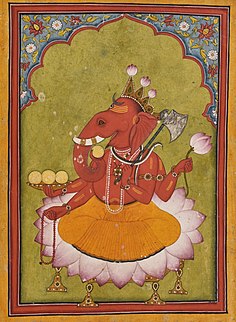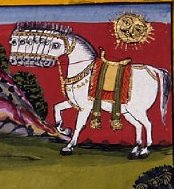 W
WThe modern practice of Hindu animal sacrifice is mostly associated with Shaktism, and in currents of folk Hinduism strongly rooted in local popular or tribal traditions. Animal sacrifices were part of the ancient Vedic religion in India, and are mentioned in scriptures such as the Yajurveda. Some Puranas forbid animal sacrifice.
 W
WGanesha, or Ganesh, also known as Ganapati and Vinayaka, is one of the best-known and most worshipped deities in the Hindu pantheon. His image is found throughout India, Nepal, Sri Lanka, Thailand, Bali (Indonesia) and Bangladesh and in countries with large ethnic Indian populations including Fiji, Mauritius and Trinidad and Tobago. Hindu denominations worship him regardless of affiliations. Devotion to Ganesha is widely diffused and extends to Jains and Buddhists.
 W
WGajarajan Guruvayur Keshavan is perhaps the most famous and celebrated temple elephant in Kerala, India. Keshavan was donated to the Guruvayur Hindu temple by the royal family of Nilambur on 4 January 1922. It is a common Hindu custom in Kerala to capture elephants either as calves or young adults from the wild and to donate them to the deity of the temple as an offering. Guruvayur temple currently has 47 elephants.
 W
WLord Hanuman is a Hindu god and divine vanara companion of the god Rama. Lord Hanuman is one of the central characters of the Hindu epic Ramayana. He is an ardent devotee of Rama and one of the chiranjeevis. He is also mentioned in several other texts, such as the epic Mahabharata and the various Puranas. Lord Hanuman is also son of the wind-god Vayu, who in several stories played a direct role in Lord Hanuman's birth.
 W
WHayagriva, also spelt Hayagreeva, is a horse-headed avatar of the Lord Vishnu in Hinduism.
 W
WMahishasura was a buffalo Asura in Hinduism. He is known among Hindus of most sects as a deceitful demon who pursued his evil ways by shape-shifting. Mahishasura was the son of Rambha, and the great-grandson of Brahmarshi Kashyapa. He was ultimately killed by Goddess Durga - after which She gained the epithet Mahishasuramardini. The Navaratri festival eulogizes this battle between Mahishasura and Durga, culminating in Vijaya Dasami, a celebration of his ultimate defeat. This story of the "triumph of Good over Evil" carries profound symbolism in Hinduism, particularly Shaktism, and is both narrated as well as reenacted from the Devi Mahatmya at many South- and Southeast Asian Hindu temples. The story is also told in the Sikh text Chandi di Var, also called Var Durga Di, which many in Sikh tradition believe was included in the Dasam Granth by Guru Gobind Singh.
 W
WNaigamesha, also known as Harinegameshi, is a goat-headed or deer-headed deity, associated with children. He also appears in Jain as well as Hindu traditions, associated with the war-god Kartikeya and childbirth.
 W
WNarasimha is a fierce avatar of the Hindu god Vishnu, one who incarnates in the form of part lion and part man to destroy evil and end religious persecution and calamity on Earth, thereby restoring Dharma.
 W
WIn Hinduism, Uchchaihshravas is a seven-headed flying horse, created during the churning of the milk ocean. It is considered the best of horses, prototype and king of horses. Uchchaihshravas is often described as a vahana ("vehicle") of Surya - the Sun-God, but is also recorded to be the horse of Bali, the king of Asuras. Uchchaihshravas is said to be snow white in colour.
 W
WVahana denotes the being, typically an animal or mythical entity, a particular Hindu deity is said to use as a vehicle. In this capacity, the vahana is often called the deity's "mount". Upon the partnership between the deity and his vahana is woven much iconography and mythology. Deities are often depicted riding the vahana. Other times, the vahana is depicted at the deity's side or symbolically represented as a divine attribute. The vahana may be considered an accoutrement of the deity: though the vahana may act independently, they are still functionally emblematic or even syntagmatic of their "rider". The deity may be seen sitting or standing on the vahana. They may be sitting on a small platform called a howdah, or riding on a saddle or bareback. Vah in Sanskrit means to ride along the land.